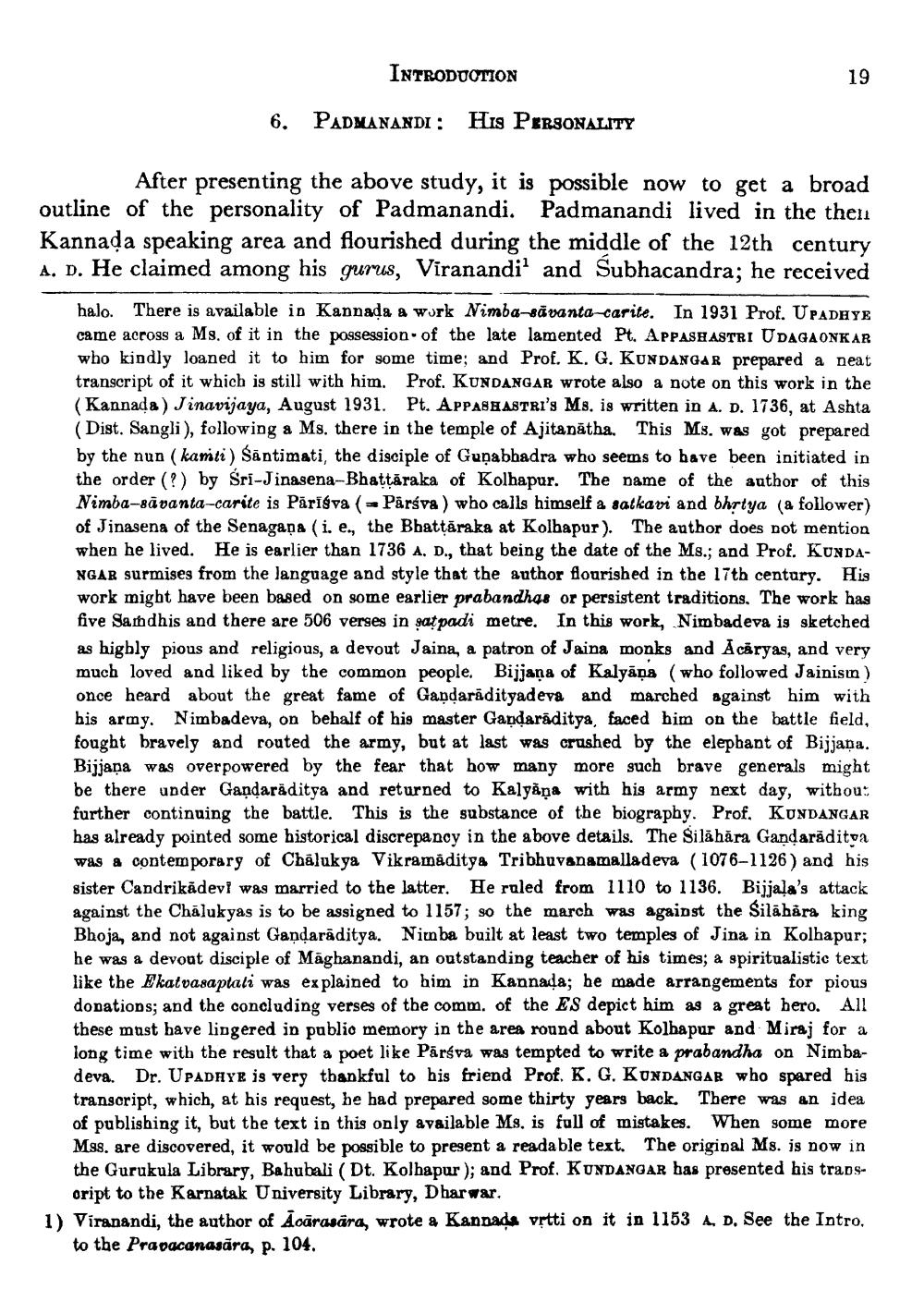________________
INTRODUCTION
6. PADMANANDI: His PERSONALITY
After presenting the above study, it is possible now to get a broad outline of the personality of Padmanandi. Padmanandi lived in the then Kannada speaking area and flourished during the middle of the 12th century A. D. He claimed among his gurus, Viranandi' and Subhacandra; he received
halo. There is available in Kannada a work Nimba-sävanta-carite. In 1931 Prof. UPADHYE came across a Ms. of it in the possession of the late lamented Pt. APPASHASTRI UDAGAONKAR who kindly loaned it to him for some time; and Prof. K. G. KUNDANGAR prepared a neat transcript of it which is still with him. Prof. KUNDANGAR wrote also a note on this work in the (Kannada) Jinavijaya, August 1931. Pt. APPASHASTRI'S Ms. is written in A. D. 1736, at Ashta (Dist. Sangli), following a Ms. there in the temple of Ajitanātha. This Ms. was got prepared by the nun (kamti) Sāntimati, the disciple of Guņabhadra who seems to have been initiated in the order (?) by Sri-Jinasena-Bhattāraka of Kolhapur. The name of the author of this Nimba-8āvanta-carite is Pārisva (Pārsva ) who calls himself a saikavi and bhrtya (a follower) of Jinasena of the Senagapa (i. e., the Bhattāraka at Kolhapur). The author does not mention when he lived. He is earlier than 1736 A. D., that being the date of the Ms.; and Prof. KUNDANGAR surmises from the language and style that the author flourished in the 17th century. His work might have been based on some earlier prabandhas or persistent traditions. The work has five Sandhis and there are 506 verses in satpadi metre. In this work, Nimbadeva is sketched as higbly pious and religious, a devout Jaina, a patron of Jaina monks and Acaryas, and very much loved and liked by the common people. Bijjana of Kalyāns (who followed Jainisin ) once heard about the great fame of Gandarādityadeva and marched against him with his army. Nimbadeva, on behalf of his master Gandarāditya, faced him on the battle field, fought bravely and routed the army, but at last was crushed by the elephant of Bijapa. Bijjana was overpowered by the fear that how many more such brave generals might be there under Gaņdarāditya and returned to Kalyāṇa with his army next day, withou: further continuing the battle. This is the substance of the biography. Prof. KUNDANGAR has already pointed some historical discrepancy in the above details. The Silähăra Gandarāditva was a contemporary of Chalukya Vikramaditya Tribhuvanamalladeva (1076-1126 ) and his sister Candrikādevi was married to the latter. He ruled from 1110 to 1136. Bijjala's attack against the Chalukyas is to be assigned to 1157; so the march was against the Silābåra king Bhoja, and not against Gandarāditya. Nirnba built at least two temples of Jina in Kolhapur; he was a devout disciple of Maghanandi, an outstanding teacher of his times; a spiritualistic text like the Ekatvasaptali was explained to him in Kannada; he made arrangements for pious donations; and the concluding verses of the comm. of the ES depict him as a great hero. All these must have lingered in publio memory in the area round about Kolhapur and Miraj for a long time with the result that a poet like Pārsva was tempted to write a prabandha on Nimbadeva. Dr. UPADHye is very thankful to his friend Prof. K. G. KUNDANGAR who spared his transcript, which, at his request, be had prepared some thirty years back. There was an idea of publishing it, but the text in this only available Ms. is full of mistakes. When some more Mss. are discovered, it would be possible to present a readable text. The original Ms. is now in the Gurukula Library, Bahubali (Dt. Kolhapur ); and Prof. KUNDANGAR has presented his trans
oript to the Karnatak University Library, Dharwar. 1) Viranandi, the author of Ācārasära, wrote a Kannada vrtti on it in 1153 A, D. See the Intro
to the Prapacanasāra, p. 104,




